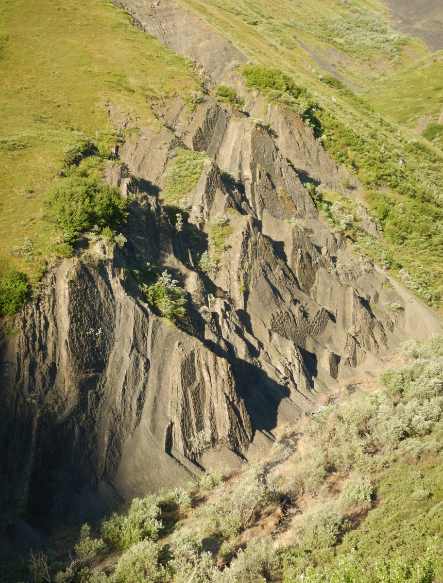Scientists from the University of Alaska Fairbanks have uncovered a remarkable discovery - the largest single dinosaur track site in Alaska, termed "The Coliseum."
Located within Denali National Park and Preserve, this expansive site spans the size of one-and-a-half football fields and showcases layers upon layers of dinosaur footprints embedded in rock, serving as a testament to the diverse species that inhabited Interior Alaska nearly 70 million years ago.

Glimpse into the Late Late Cretaceous Period
The Coliseum unveils a glimpse into the Late Cretaceous Period, where the cliff formations seen today were once sediment deposited on a flat terrain adjacent to a presumed watering hole in a flood plain.
As tectonic forces shaped the Alaska Range, the once-level ground folded and tilted vertically, revealing cliffs adorned with these prehistoric tracks. These tracks encompass a mix of imprints etched into ancient mud, as well as casts formed when sediment filled the tracks and subsequently solidified.
Dustin Stewart, lead author of the study and a former graduate student at UAF, noted the exceptional nature of this find, remarking, "It is a sequence through time. Up until now, Denali had other track sites that are known, but nothing of this magnitude."
The initial impression of the site might not reveal its true significance within the broader park landscape - merely a stratified, rocky outcrop ascending some 20 stories from its base. Stewart recounted his initial underwhelmed reaction upon approaching the site, which transformed as the sun's angle illuminated the tracks.
Beyond the tracks, the site has provided a treasure trove of information about the Late Cretaceous ecosystem. Fossilized plants, pollen grains, and remnants of freshwater shellfish and invertebrates have enriched the researchers' understanding of the surrounding environment.
This area was part of an expansive river system with nearby ponds and lakes, boasting a climate warmer than the present day, reminiscent of the Pacific Northwest, according to the researchers.
"World-class Area for Dinosaur Tracks"
The footprints offer insight into the diverse inhabitants of the region over millennia. Among the most common were the large herbivorous duck-billed and horned dinosaurs. However, rarer carnivores like raptors and tyrannosaurs also left their mark, alongside smaller wading birds.
Denny Capps, the park's geologist, acknowledged the importance of preserving sites like The Coliseum. He emphasized the National Park Service's dual role of safeguarding these world-class fossil sites from disturbances while encouraging visitors to explore them in their geological context to understand the evolution of landscapes and ecosystems through time.
As the study continues, the Denali National Park and Preserve appear to hold much more untapped potential. Druckenmiller, who led the research, affirmed the significance of the site by stating, "Our track research in the park compliments our work on dinosaur bones we collect in northern Alaska, along the Colville River.
"Denali National Park and Preserve is a world-class area for dinosaur tracks. There is a lifetime of exploring left to do, and I can only wonder what other surprises await."
The findings of the team were published in the journal Historical Biology.
Related Article : AI Shows that This Dinosaur May Have Been a Friendly Herbivore





